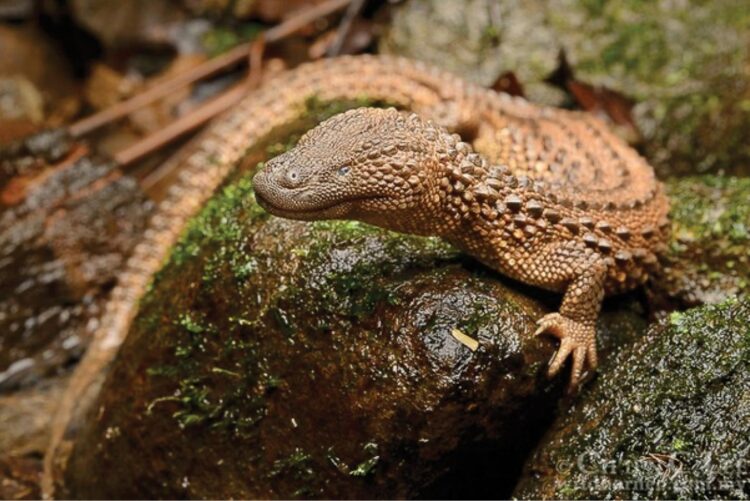Should zoos display legally protected species that have been smuggled out of their range countries? A new study suggests that a pause and rethink may be needed, as it reports that accredited zoos have acquired a rare and legally protected reptile, the earless monitor lizard endemic to Borneo, without any evidence that the animals were legally exported.
The earless monitor lizard occurs only on the island of Borneo and has been described as a “miniature Godzilla” and “the Holy Grail of Herpetology.” Discovered by western scientists almost 150 years ago, for most of this period the species was known largely from pickled specimens in natural history collections, and wasn’t recorded from the wild for decades. In the 1970s, the three countries that make up Borneo – Indonesia, Malaysia and Brunei – added it to their protected species lists. This means that the species can neither be legally traded within these countries, nor legally exported out of them.
Despite legal protection and lack of export permissions, reptile enthusiasts and unscrupulous traders have long been smuggling small numbers of earless monitor lizards out of Indonesia and Malaysia, eventually bringing them to Europe. This greatly accelerated in 2012, when the species’ rediscovery was announced in a scientific journal. In 2016, all 183 countries that are signatory to the Convention on international trade in endangered species agreed to regulate global trade in earless monitor lizards in order to limit the negative effects of smuggling on wild populations. Agreed export numbers were set at zero.
Enforcing the laws has proven to be challenging, however, and to date only two smuggling attempts have been thwarted. In both cases, German smugglers were apprehended at Indonesian airports while attempting to move respectively eight and seventeen earless monitor lizards out of the country.
The first zoo that proudly announced it had obtained earless monitor lizards was Japan’s iZoo in 2013. This zoo is not accredited, and the ways in which the animals were obtained remain questionable. In Europe, the first zoos to openly display earless monitor lizards were located in Hungary, Austria and the Czech Republic. The animals were obtained from what zoos referred to as “private individuals” or “dedicated hobby breeders”, and, in one instance, from iZoo. Just like in Japan, how these animals ended up in Europe is questionable, but perhaps not illegal – and it is evident that no export permits were ever issued.
In recent years, more and more zoos in Europe, and since the beginning of this year also in the United States, have started displaying earless monitor lizards. Some cases were part of zoo exchanges, others were obtained from private individuals, and a handful were placed in zoos by authorities after they were seized, but it is clear that many were at one point illegally exported out of Indonesia, Malaysia or Brunei, or were illegally imported into non-range countries.
The acquisition of these protected lizards by zoos is neither in line with the intentions of national laws of their countries of origin, nor with international wildlife trade regulations. Moreover, it is diametrically opposed to the commitments the international zoo community has made to address illegal wildlife trade.
“To me, the current situation concerning the purchasing and proudly displaying of earless monitor lizards by accredited zoos can be compared with a road safety organisation posting online videos of its CEO doing wheelies on a motorbike and then adding that it was done on a private road where neither wearing a helmet nor having a driver’s licence is required,” said Vincent Nijman of the Oxford Wildlife Trade Research Group, author of the study that was published in the open-access journal Nature Conservation. “Both may be legal in a technical sense, but the optics are not good.”
“Modern, scientifically managed zoos are increasingly organising themselves with set ethical values and binding standards which go beyond national legislation on conservation and sustainability, but, unfortunately, this still only counts for a small proportion of zoos worldwide,” said Dr Chris R. Shepherd, Executive Director of Monitor Research Conservation Society. “Zoos that continue to obtain animals that have been illegally acquired, directly or indirectly, are often fuelling the illegal wildlife trade, supporting organised crime networks and possibly contributing to the decline in some species.”
Seven years ago, the price for a single earless monitor lizard was in the order of EUR 8,000 to 10,000 , so any zoo or hobbyist wanting to have one or more pairs had to make a serious financial commitment. These high prices put a restriction on the number of people that wanted to acquire them and could afford them. It probably also gave potential buyers a tacit reminder that the trade was illicit. In recent years, however, prices have come down, to less than EUR 1,000. Now that earless monitor lizards are more affordable, and with accredited zoos giving a sense of legitimacy, Nijman is concerned that it might become more and more acceptable to keep these rare animals as pets.
“When I grew up in the 1970s, it was still perfectly acceptable for what we now see as accredited zoos to regularly buy rare and globally threatened birds, mammals and reptiles from commercial animal traders. Few questions were asked about the legitimacy of this animal trade. This has dramatically changed for the better, and now many of the animals we see in zoos today have been bred in captivity, either in the zoo itself, or in partner zoos”, Nijman said. He added that in many ways zoos are a force for good in the global challenge to preserve species and conserve habitats. “It is imperative that these efforts are genuinely adopted by all in the zoo community, and, when there is doubt about the legitimacy of animals in trade, that a cautionary approach is adopted.”
###
Original source:
Nijman V (2021) Zoos consenting to the illegal wildlife trade – the earless monitor lizard as a case study. Nature Conservation 44: 69-79. https:/
Media Contact
Vincent Nijman
[email protected]
Related Journal Article
http://dx.





